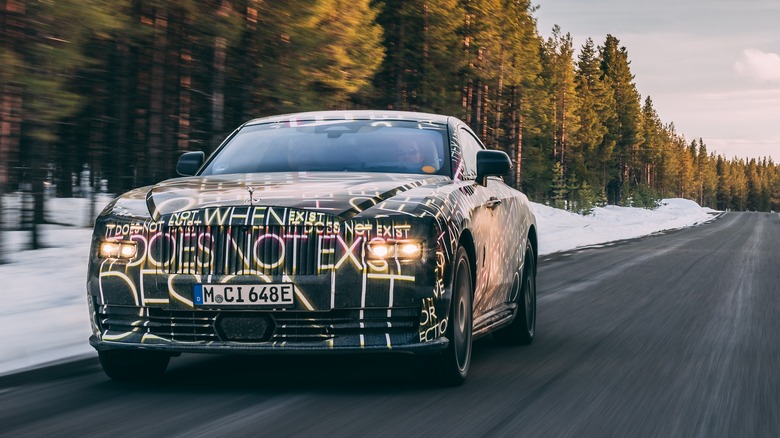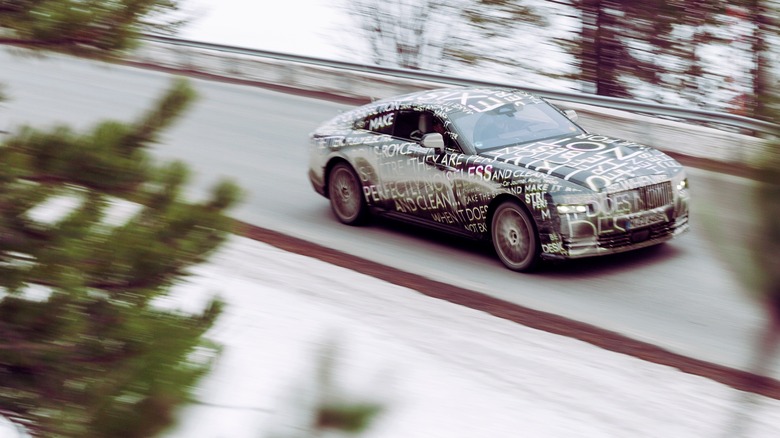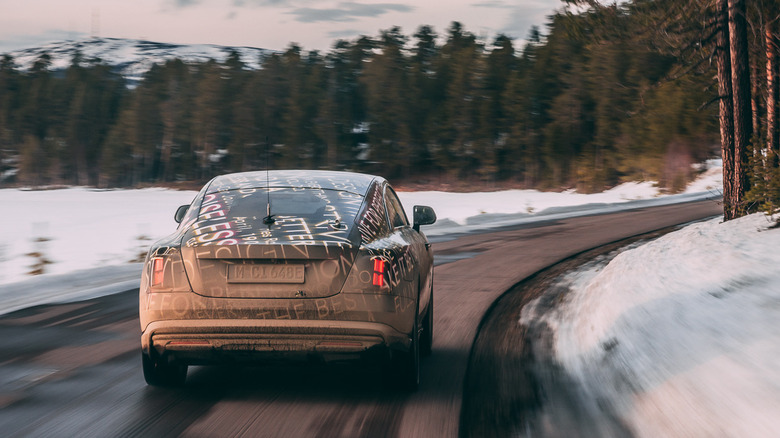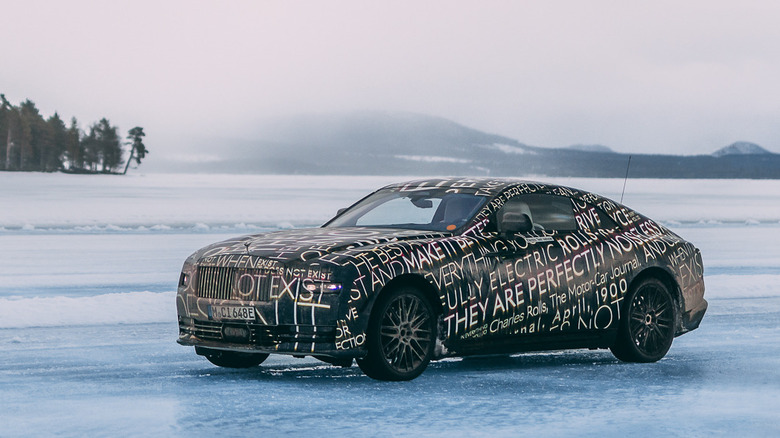After Seeing Rolls-Royce's Spectre EV In The Snow, We Have Questions
Rolls-Royce promised something big from its first all-electric production car, and Spectre is shaping up to satisfy that commitment both literally and spiritually. Photos are deceptive. At first glance, the work-in-progress EV doesn't look like it would be especially huge — by Rolls-Royce standards, at least — but, according to the automaker, its dimensions are far from humble. In fact, it's more akin to the dearly-departed Phantom Coupé, the two-door which was discontinued in 2016.
That was over 18 feet in length, though Rolls-Royce isn't saying that Spectre will be exactly matching the sheer scale. However, with confirmation that the new electric coupe will be riding on vast, 23-inch wheels, it's enough to leave us recalculating our mental image of just how large Spectre will be.
Though the 6.75-liter V12 may not have been handed over from the Phantom Coupé, Spectre will inherit its split headlights. The windshield rake is even more dramatic, meanwhile, helping with both the silhouette and the aerodynamic slipperiness. A similarly pared-back Spirit of Ecstasy hood ornament helps Spectre hit a mere 0.26 drag coefficient, at least in Rolls-Royce's early prototypes.
A luxury British computer on wheels
Without 12 cylinders to manage, you'd be forgiven for thinking the electric coupe's drivetrain would be a more simplistic affair. Not so, Rolls-Royce counters, pointing out that the new two-door is its "most connected" model so far, with a significant uptick in the intelligence of each module.
There are over 4.3 miles of cabling in each EV, linking the electronics together in a way that bypasses centralized processing in the name of speed and flexibility. That partly reflects the pace of the auto industry and its engineering in general, but it also sets Rolls-Royce the challenge of dialing in a driving experience that not only capitalizes on the core advantages of electrification – like lashings of instantaneous torque – but still holds true to what owners have come to expect from the marque.
Spectre in the snow
A trip to the extreme cold-weather facility in Arjeplog, Sweden, proved to be an opportunity to put those capabilities to the test, not to mention a chance to see whether more mundane — but no less important — mechanical components like seals, bushings, and glues hold up to -40 degrees Fahrenheit temperature in the near-arctic conditions.
Ironically, the fact that low-friction ice and snow are so instantly challenging is actually an advantage, Rolls-Royce points out, when you're trying to ensure a certain character. Events that might ordinarily require very fast speeds to provoke, like loss of traction, can be arranged at a far more leisurely pace, making it easier to tweak how your EV responds.
Cold-weather testing is an inevitability for every new car, of course, as automakers check to see how well their models hold up to extreme situations. For electric vehicles, though, the stakes are arguably even higher. One of the challenges of EV drivetrains is how unhappy batteries can be made by low temperatures and the ensuing hit on the potential range that can deliver.
For EVs, cold means compromise - Rolls-Royce doesn't like that
There are, unsurprisingly, several ways to try to mitigate that challenge. The easiest is to add more battery, though that comes with issues of its own: it leaves an electric vehicle more expensive for a start, not to mention heavier. Heat pumps are another strategy, effectively using ambient temperatures to help precondition the cabin temperature, in the process spending less power on the HVAC system. That leaves more juice for actual driving.
The whole topic is an even bigger concern for an automaker like Rolls-Royce, for which demanding compromise on the part of owners is close to anathema. While even luxury car companies can't entirely vanquish physics, they can capitalize on some of the side benefits that a switch to electrification offers.
Quieter, cleverer, and even more lavish
In the case of Spectre, one of those is a secondary purpose for the EV's battery. Its eventual addition was already designed into the Architecture of Luxury, but the automaker is branding its arrival as Rolls-Royce 3.0. The floor of the car is positioned halfway between the sill structures, leaving an aerodynamic channel into which the battery can be added without forcing the seat height to rise.
The battery itself is around 1,500 pounds — Rolls-Royce will confirm Spectre's actual range closer to the EV's launch — and it's doubling as sound deadening. By routing wires and piping through channels between the floor of the car and the top of the battery, the pack has become an instrumental part of the coupe's isolation from the road. No Rolls-Royce is noisy inside, but we'll be mighty curious to see just how hushed the Spectre experience can be made.
The process of bringing Rolls-Royce 3.0 to a production model still is far from complete. So far, only 25% of the 1.55 million mile testing that the automaker has in mind has been completed, something that in the end should help simulate around 400 years of use. That leaves plenty to do before the first customer deliveries begin in Q4 2023.




